No Guts, No Story: The Moth's Monthly Ann Arbor StorySLAM

Every month crowds gather at Circus for The Moth StorySLAM, Ann Arbor's live, local version of the hugely popular NPR radio show The Moth Radio Hour. Just like the show, Ann Arbor's StorySLAM features true, personal stories told by people of all ages, backgrounds, and storytelling skill-levels--as long as they've got the guts to get up on stage and tell.
At this past Tuesday’s Ann Arbor StorySLAM, storytellers had to bring twice the guts--because “Guts” was also this month's theme. Satori Shakoor, creator, producer, and host of The Secret Society of Twisted Storytellers, was StorySLAM's enthusiastic host, welcoming storytellers to the stage and reading brief “times I chickened out” anecdotes submitted by the audience in between stories. Storytellers displayed a wide range of abilities as they shared a diversity of "gutsy" stories. Opener Karin Lindstrom told a dramatic tale of having to kill a beloved horse, while eventual winner Lauren Trimble shared a tearful story of having to identify the body of her dead brother. Other storytellers interpreted “guts” more literally; KT Doud told a story of offending international hosts by refusing to eat intestine soup… and then accidentally furthering the offense with too many tequila shots.
Circus makes a great venue for the event, with its raised stage and combination of tables, chairs, and standing room. It’s fun to see the different abilities of the storytellers and their individual interpretations of each monthly theme. For those who don't faint dead away at the thought of public speaking, it's actually pretty easy to join in on one of these StorySLAMs. Those who wish to tell a story submit their name and 10 random storytellers are chosen to share their 5-minute story with the crowd and with a panel of judges. The StorySLAM winner continues on to compete in a larger GrandSLAM, a storytelling event with winners from StorySLAMs around the country.
Elizabeth Pearce is a Library Technician at the Ann Arbor District Library.
Ann Arbor's StorySLAM is sponsored by Michigan Radio and is held on the third Tuesday of every month at Circus. The event will be back on November 17, with the theme “Gifted,” and on December 15, with the theme “Joy.” Tickets are $9 each for nonparticipants, and you can buy them online in advance or at the door. For more information and Detroit dates, visit the Moth events website.
POP•X Overview

POP•X is real art in real time. And it’s an idea that’s been long overdue as Ann Arbor’s been inching its way towards this sort of event for some time now. After all, in the sphere of local music, Water Hill’s now established spring music festival has shown us how this sort of spirited activity can be handled on what is a seemingly near ad hoc basis. In this instance, POP•X is telling us in quite vivid terms: Create and they will come. During a recent midday visit at the start of the event, I saw Ann Arborites of all ages, all incomes, and all backgrounds; all crafting, browsing, and participating in what would have seemed an unlikely set of circumstances just days before.
Using Liberty Plaza as its base, POP•X effectively has melded a cluster of arts activities that have been percolating historically. But it’s also done so with a bit of Tree Town spirit.
For one of the most dispiriting effects of the 20th century visual arts has been the progressive commodification of aesthetics. Read any report about art anywhere and there’s either a subtle (or often not so subtle) reference to the monetization of the visual arts. It’s no secret that big art can wheel about untold millions of dollars with the stroke of a pen or the slam of an auctioneer’s gavel and it’s very often seemed as though this is meant to be the end product of the artistic activity.
As a result, this reification of art’s value has put a price tag on all artful activity with a grimness that squeezes joy out of the market. Art can be big business and engaging in art can be to participate in big business. It is not accidental that someone with as clever a sense of humor as Andy Warhol decided in his time to reflect this ultimately simple-minded commodification.
Well, to use a telling cliché, POP•X puts paid to this notion. Like Water Hill Music Festival—and unlike the now merchandizing effort of each summer’s local art fairs—this event is a free-for-all of artistic opportunity. Granted, it took a consortium of like-minded individuals at all levels of the regional arts market to gather themselves towards this end. And it ultimately took the nuanced and steely courage of professionals and visionaries like Omari Rush and Lucie Nisson to organize the event as well as seek and/or provide the funding. But the synergy once released has taken on a community-tinge that’s unmistakably organic.
For example, the very nature of the buildings crafted to house the individual projects in POP•X is unmistakably, and deliberately, unrefined. And the repurposing of these structures after the event ends calls into mind this very orientation: Waste not, want not.

But even more astute is the nature of the project itself.
POP•X isn’t an under-conceptualized happenstance; rather, the very nature of the project follows a clearly delineated path of artful logic in modern and post-modern art that’s been percolating for decades now. The event mirrors two of the more outrageous innovations of mid-20th century Neo-Dada—the notions of the Happening and Environmental Art.
The Happening, a sort of odd participatory aesthetic has always been subversive in its insistence on the involved hands-on element of creativity. Rather than surrender to the notion that art must be respectful (in other words, passively sitting on a gallery wall or be passed around dollar for dollar), the accomplices of this art form yield to the collective experience of the event. A sort of late-blooming offshoot of Dada, the Happening sought to push the boundaries of art in much the same way that Luigi Pirandello and Bertholt Brecht sought to push the boundaries of theatrics: Participating in the event is the art form.
Likewise, another 1960s offshoot of Neo-Dada, Environmental Art, also sought to widen the physicality of art itself—and hence, the expansive nature of art. As POP•X happily shows us, the very creation of this environment lays a foundation upon which everything else rests. As such, in some of the units, professional artists have invited the public to participate in the creation of the art activity itself, while other groups or individuals have mounted installations through which we can participate.
The end result is a heady optimism that’s infectious and it’s this invigorating cheerfulness that most succinctly describes the atmosphere of this event. And like all environmental give and takes, what one encounters will be dictated by those who are there at the same time. It’s therefore going to be useful to visit the installation site occasionally—and certainly at differing times—to absorb the varied populations that inhabit this artistic fishbowl.
Just don’t expect POP•X to conform to the tried and (supposedly) true formula of the contemporary visual arts. For its multidimensional psychological and physical bearings embroider the varied elements of the contemporary arts. There’s going to be a bit something different here for everyone.
Little surprise then that yet one final cliché fits the parameters of POP•X.
Perhaps for the first time in a long time, our local proponents of the visual arts have banded together to acknowledge a fact about art that a city the size of Ann Arbor has seemingly been built to express: It’s taken a village to express Ann Arbor’s attitude about contemporary art.
Here’s hoping this remarkable achievement is but the first of many such activities that will take place in our future.
John Carlos Cantú has written extensively on our community's visual arts in a number of different periodicals.
POP•X is an annual ten-day festival presented by the Ann Arbor Art Center. POP•X 2015 was Thursday, October 15 – Saturday, October 24, 2015 from 10 am to 8 pm at Liberty Plaza Park, 255 East Liberty St, Ann Arbor. To learn more visit popxannarbor.com or the POP•X Facebook event page. POP•X is free and open to the public.
Preview: Titus Andronicus, Huron Players, Huron High School

“Oft have I digg'd up dead men from their graves, And set them upright at their dear friends' door….”
Just in time for Halloween (and running the following weekend), Ann Arbor High School’s Huron Players bring you Shakespeare’s most disturbing tragedy, Titus Andronicus.
In this blood-soaked drama -- one of Shakespeare’s earliest, written sometime between 1588 and 1593 -- Saturninus and Bassianus are vying for the title of Caesar when Titus returns victorious from war with the Goths. Titus is offered the emperorship, but instead confers the title on Saturninus, thereby setting in motion a revenge so shockingly graphic the play wasn’t performed for centuries. Let’s just say that in addition to the considerable bloodshed, Titus cornered the meat-pie market a good 400 years before Sweeney Todd.
Amy Cantú is a Production Librarian at the Ann Arbor District Library.
Titus Andronicus starts Friday, October 30, 7:30 pm, with additional performances Sunday, November 1, at 2:00 pm, Friday, November 6, and Saturday, November 7, at 7:30 pm in Huron High School's Little Theater. General admission: $8, students and staff $6. Additional information available on the Huron Players website.
Preview: a unique americana duo comes to Old Town Sunday night
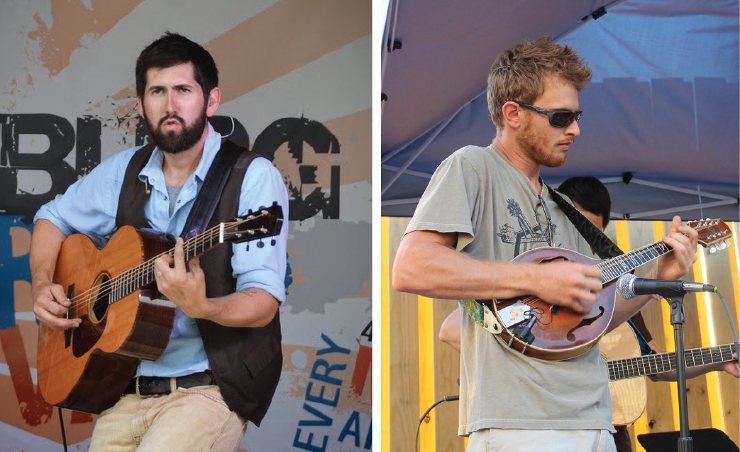
Sunday evening live music at the Old Town Tavern is a long-time staple for many locals. This Sunday’s show should be particularly rousing. Guitarist and singer Kyle Rhodes, from the local band Wire in the Wood is teaming up with Jay Lapp, frontman of the Virginia bluegrass band Steel Wheels to form an Americana duo playing a fusion of bluegrass, jazz, and indie rock. Mandolin fans in particular won't want to miss this show: both Rhodes and Lapp are accomplished mandolin players and we can expect the instrument to feature prominently in Sunday's show, too.
Wire in the Wood, first formed in 2008, also features Billy Kirst, Jordan Adema, and Ryan Shea. Formerly known as The Bearded Ladies, the band got their start when Kirst put an ad on craigslist seeking bandmates for the “Best String Band Ever.” Rhodes was the only one who answered the ad, and Wire in the Wood was born. The band frequently plays at the Corner Brewery in Ypsilanti.
The Steel Wheels is also comprised of four young musicians who first met when they were in school at Eastern Mennonite University in Virginia. The four band members—Lapp, Trent Wagler, Brian Dickel, and Eric Brubaker—were all raised in Mennonite families. The band played informally together throughout the late aughts, while also working day jobs and starting families, and released an LP in 2007. In 2010, they finally came together as The Steel Wheels, and have been releasing albums ever since, including their most recent one Leave Some Things Behind, which came out this past May. The band puts on the Red Wing Roots Music Festival every year in Virginia. 2015 was the third year of the festival.
Elizabeth Pearce is a Library Technician at the Ann Arbor District Library.
Jay Lapp & Kyle Rhodes will begin their set at Old Town at 8:00 pm this Sunday, October 25. Old Town features live music every Sunday, from artists of all types, as well as live jazz music on Tuesday evenings. You can find out more about upcoming shows and performers here.
Art Blooms in Hamtramck
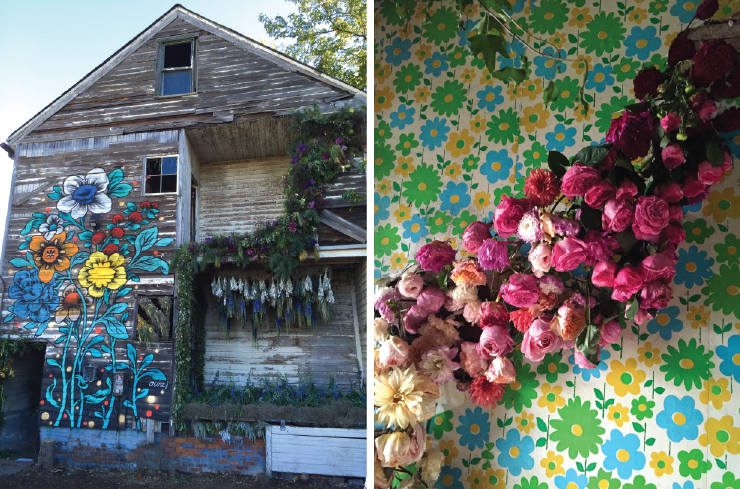
Crowds flocked to a vacant house on Dequindre St. in Hamtramck this weekend, all seeking an experience more likely to be found in a botanical garden or conservatory. The house, named simply Flower House, was created by Lisa Waud of Ann Arbor and Detroit-based Pot & Box, and features an amazing large-scale floral installation created using American-grown fresh flowers and living plants.
Waud and a team of floral designers from Michigan and throughout the country came together to create stunning floral installations throughout every room of a vacant and dilapidated house, sometimes extending from ceiling to floor or wall to wall.
During the three-day sold-out event, over 2,000 attendees each had 20 minutes to make their way through all 17 rooms in the house and revel in the experience. Walking through the dreamscape and floating from room to room was completely enchanting, and absorbing your surroundings was a delightful challenge. Your eyes roamed around in sensory overload trying to take in each room as a whole while also trying to notice all of the beautiful details tucked into every nook and cranny.
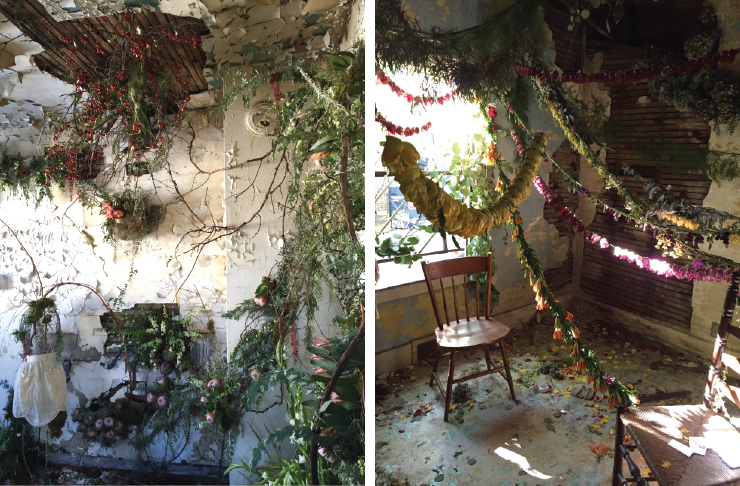
The bedroom housed a bed made of moss and branches, the bathrooms featured the prettiest, sweetest-smelling toilets you’ve ever seen, and the colorful old kitchen cupboards were adorned with greens amid the plates and silverware. Tulips dripped from the ceiling alongside peeling paint, interwoven marigolds created a playful shower curtain, and vegetables cascaded gracefully over crumbling walls. To complete the scene, the house was enveloped in the crisp smell of thousands of flowers on a chilly fall day while the admiring gasps of awestruck onlookers created a chorus to accompany the dreamy beauty of Flower House.
With the installation now ended, the house and its neighboring vacant house will be deconstructed and the materials will be repurposed. The land will then be turned into a flower farm and design space, in a continuation of Flower House's success in growing fresh beauty from a tired landscape.
Amanda Schott is a Library Technician at the Ann Arbor District Library.
PREVIEW: Abdullah Ibrahim & Ekaya, Jazz Series, University Musical Society

The October 21 University Musical Society performance by Abdullah Ibrahim & Ekaya at the Michigan Theater in Ann Arbor is a unique opportunity to hear voices of South Africa through this legendary jazz piano master and his extraordinary young group.
Whether you know the sounds of Soweto from Hugh Masakela’s horn, Miriam Makeba’s “Click Song”, the high harmonies of the Mahotella Queens, or the bell-shuffle-sweep of Ladysmith Black Mambazo’s joyous a cappella songs, Ibrahim sifts and swaps all of it! The soaring horns of Ekaya behind Ibrahim’s hymn-like chording and glistening vamps will take you places that only great music can go. Take this chance to hear why the great Duke Ellington launched this big talent with a 1963 Paris recording, and why Abdullah Ibrahim still delights audiences around the world 52 years later, at age 81.
Ira Lax is an Outreach and Neighborhood Services Technician at the Ann Arbor District Library
Abdullah Ibrahim and Ekaya perform at the Michigan Theatre on Wednesday, October 21 at 7:30 pm. Tickets are available online, by phone at 734-764-2538, or at the Michigan Theatre door.
Preview: Hubbard Street Dance Chicago

The modern dance company Hubbard Street Dance Chicago will be visiting the Power Center for a one-night only performance on Tuesday, October 27th at 7:30pm. UMS is bringing this fantastic group to Ann Arbor as part of its 2015/2016 Dance Series, and I can’t wait to see them again!
Hubbard Street Dance Chicago provides an excellent introduction to modern dance, as they are much more accessible than many groups; they are also sufficiently excellent to hold the attention of any dance lover. Hubbard Street tends to bring a mix of fun and serious pieces, all of which are expertly danced and easy to follow. The program that they are bringing to the Power Center this fall is all choreographed by one person, William Forsythe. Although a program of only one choreographer’s work can be a dicey prospect, I have no doubt that Hubbard Street can pull it off with grace and beauty.
For those of you who are interested in a more immersive experience, Hubbard Street will also be offering a free master class at the Ann Arbor YMCA on Saturday, October 24th at 2pm. This is a great opportunity to dance and learn from some of the best modern dancers in the US. I have taken this class before, and it’s great fun! If you want to learn more about Hubbard Street, but aren’t ready to take a class, show up early to the performance at the Power Center--there will be a short talk at 7pm.
Evelyn Hollenshead is a Youth Librarian at the Ann Arbor District Library.
Hubbard Street Dance Chicago performs Tuesday, October 27 at 7:30 pm at the Power Center with a talk at 7. Tickets are available online, by phone at 734-764-2538, or at the Ticket Office in the Michigan League.
Orange is the New Maize & Blue
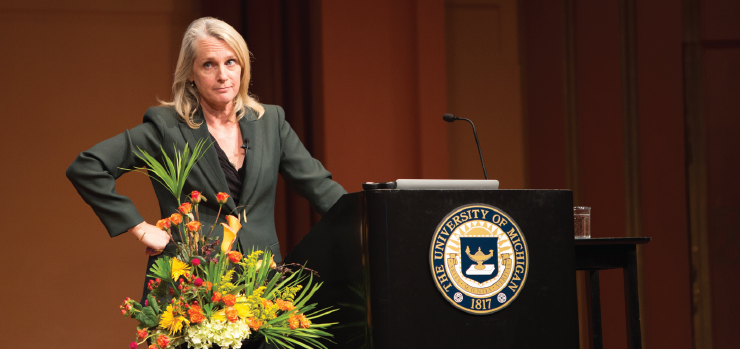
When Piper Kerman, New York Times bestselling author of Orange is the New Black, gave the biennial Vivian R. Shaw Lecture last week at the University of Michigan, she drew a crowd which filled Rackham Auditorium and required live-stream video and overflow seating. Kerman’s memoir of her experience serving time in a women’s prison was adapted into a wildly popular, award-winning Netflix series by executive producer Jenji Kohan in 2013.
Kerman’s presence throughout the lecture was relaxed, yet pointed and, at times, refreshingly irreverent. She opened the lecture by describing life prior to her 13-month incarceration at the Federal Correctional Institute in Danbury, CT. As she chronicled her time behind bars, the themes of her lecture were clear: sisterhood and empathy, gender, power, and racial inequality. Her presentation raised awareness about some damaging stereotypes and stigmas of incarcerated women, as well as challenges that occur upon re-entry to society. Kerman encouraged the audience to use the show as a lens into the greater institutional and systematic oppressions of mass incarceration and how they impact women prisoners – specifically women of color. The Q&A session that followed touched on a variety of topics including popular culture and identity, the importance of arts within prisons, and how to donate books to incarcerated women.
While Kerman currently serves as a consultant for the show, she’s also adamant about supporting nonprofits and other organizations working to advocate for female prisoners, their families, and overall prison reform. Additionally, she teaches creative writing courses to female inmates and serves on the board of the Women’s Prison Association. She has been called as a witness by the U.S. Senate Judiciary Subcommittee on the Constitution, Civil Rights, and Human Rights to testify on solitary confinement and women prisoners. She has spoken at the White House on re-entry and employment to help honor Champions of Change in the field. In 2014, Kerman was awarded the Justice Trailblazer Award from John Jay College’s Center on Media, Crime & Justice and the Constitutional Commentary Award from The Constitution Project.
In this talk, Kerman offered incredible insight and compassion as she both humanized female prisoners and advocated for thoughtful, intentional, and long-term policy changes.
The 2015 Vivian R. Shaw lecture was co-sponsored by the Institute for Research on Women and Gender, Women Studies Department, Michigan Law School, the Gerald R. Ford School of Public Policy, the School of Social Work, the Department of Screen Arts and Cultures, the Department of Sociology, and the Screen Arts and Cultures Screenwriting Program.
Community contributor CristiEllen Heos Zarvas is the Meetings and Special Events Assistant for the Institute for Research on Women and Gender at the University of Michigan.
Review: POP•X
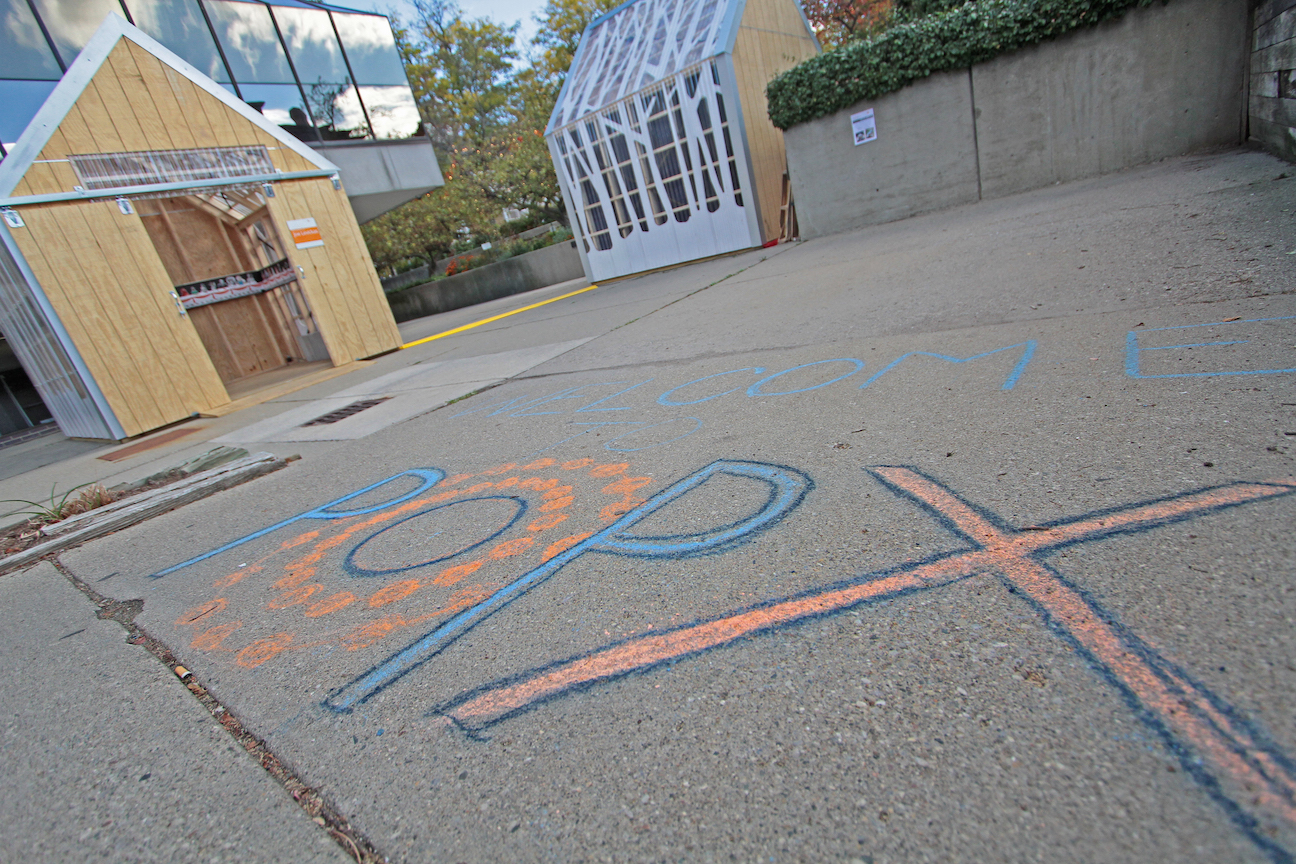
At the entrance to a 10’ x 10’ pavilion made of plywood and corrugated plastic at the edge of Liberty Plaza, I feel like I’m peering into some sort of mystical forest. Past the artificial palm fronds that frame the doorway, there are tall, mossy, finger-like artificial rocks awash in gentle blue light. Cottony clouds hang from the ceiling and recorded sounds of wind and woodland activity play softly.
A sweatshirt-clad, middle-aged man with a scraggly beard steps up behind me and I turn around. His expression is puzzled.
“Is there weed in there or something?” he asks.
“No,” I reply. “It’s an art installation.”
The pavilion containing Ann Arbor artist Nick Zagar’s forest landscape is one of eight pop-up structures comprising the Ann Arbor Art Center’s new POP•X exhibition in Liberty Plaza. Even at a cordoned-off POP•X preview event, it’s impossible not to confront the odd dichotomy between the plaza’s typical usage and the purpose it will take on for the next 10 days. Ann Arborites know the downtown park as a regular hangout for the homeless, the subject of repeated city council debate. Through October 24, however, it will be the site for POP•X, which organizers describe as the first step in a larger mission to create more publicly accessible art experiences in the Ann Arbor community.
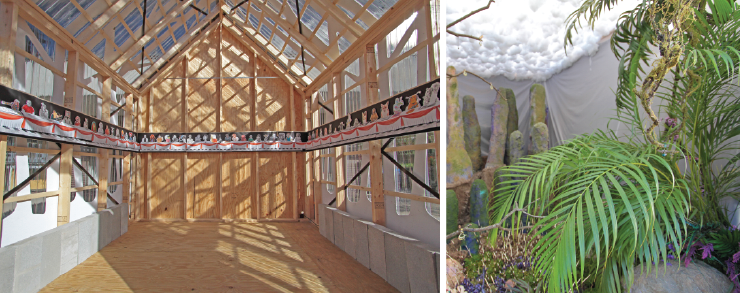
All eight pavilions look essentially the same from the outside: unfinished wooden doorways at the front and back, with white silhouettes of trees crisscrossing the transparent sides and roofs. Inside, each pavilion is unique, tailored to the eccentricities of the artist or group who worked on it. Where Zagar fills his entire pavilion with his fantasy naturescape, artist Joe Levickas’ pavilion contains just a narrow band of illustrations of cartoon figures sitting down to a dinner party, like a surrealistic 50-person “Last Supper” stretching across three walls.
However, the most interesting pavilions at POP•X are those that directly engage with Liberty Plaza’s usual population and associated issues of economic disparity. Brenda Oelbaum’s somber installation uses black curtains to block out the light that streams into most POP•X pavilions, with a large mural inside presenting a quote Oelbaum’s grandmother adapted from Herodotus: “If we all put our troubles in bags and took them to the market to exchange them, upon seeing the problems of others we would gladly go home with our own.” Visitors are encouraged to write down their problems and leave them anonymously in a pile of small black pouches. Visitors may then read others’ problems and “purchase” them for a donation to the Ann Arbor Community Center or Mercy House, both charities supporting Ann Arbor’s hungry and homeless.
Just across from Oelbaum’s installation is a pavilion designed by the nonprofit Girls Group, which focuses on empowering young Ann Arbor and Ypsilanti women to stay in high school or college and avoid teen drug use and pregnancy. The group’s young participants have contributed a variety of works based on the concept of “home.” The most powerful work in the pavilion is a looping video of Dea Chappell, a fiery young Ann Arbor poet and high school junior, reading her poetry. “Welcome to black America,” Chappell almost sobs. “I can’t breathe…but black lives matter, right?” Standing by her untitled collage addressing themes of black sisterhood and protest, 17-year-old Skyline High School student Alexandra Cash tells me living in Ann Arbor has made her more aware of her “blackness.” “You can be really smart and get really good grades but still be on the lower end of the white kids,” Cash says.
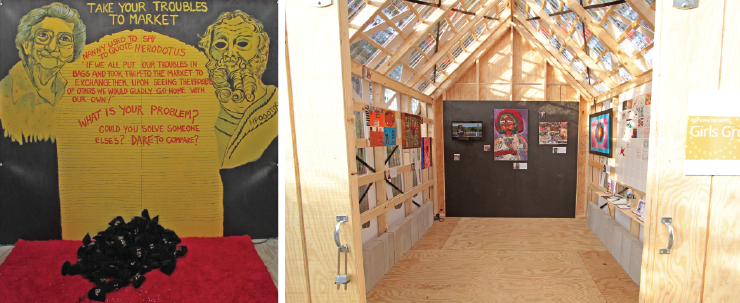
Ypsilanti artist Nick Azzaro’s pavilion provides POP•X’s most direct statement on Liberty Plaza’s usual inhabitants, and one of the most powerful statements in the show overall. At the center of Azzaro’s installation is “The Statue of Liberty Plaza,” a figure built from hundreds of tiny plastic army men and other military-related toys, posed in the form of Lady Liberty. The figure wears torn jeans, stuffed with newspaper and corrugated cardboard. In one hand it holds a copy of Groundcover News, in the other a sign reading “HOW ARE YOU TODAY?” On the walls surrounding the statue are professional portraits of individuals Azzaro met while spending an average, non-POP•X day in Liberty Plaza. The portraits are larger than life and most of the subjects grin broadly as they look directly into the camera, a white background behind them. Azzaro’s work encourages visitors to gaze upon the “huddled masses” we might otherwise ignore as we walk past Liberty Plaza, and to find a welcoming expression and a human story there.
Adjacent Azzaro’s pavilion is a more traditional representation of Ann Arbor’s art establishment. The Ann Arbor Women Artists’ pavilion, a collaboration between 30 of the 64-year-old organization’s members, is a delightful Art Nouveau-inspired outdoor picnic scene. Ruffled tissue-paper grass surrounds a painted pathway through the pavilion, suggesting a river. Plates are heaped with clay and Styrofoam fruits and vegetables, and dragonflies made of wire and tissue paper float overhead. It’s lavish, lovely and certainly more focused on craftsmanship and aesthetic beauty than political commentary.
But that’s part of why POP•X works so well. I was initially unsettled by the idea of an art show displacing Ann Arbor’s less fortunate for 10 days. But while POP•X’s organizers set out to bring art to the whole community, they’ve achieved something even higher: bringing our community face to face with itself. POP•X doesn’t whitewash Liberty Plaza for the enjoyment of some artistic elite, nor does it shut out more traditional voices from our local art scene. It forces anyone who explores all eight pavilions to confront diverse aspects of a complex town that is too often described in generalizations. Here, a Liberty Plaza regular may wander through the Women Artists’ picnic wonderland, or one of the well-dressed socialites I rubbed shoulders with at the preview event may take a moment to look into the eyes or listen to the words of Ann Arborites considerably less fortunate than him or herself. POP•X is many things: fun, sobering, beautiful, contemplative. But most importantly it’s responsible and respectful to the full scope of the community it represents.
Patrick Dunn is an Ann Arbor-based freelance writer whose work appears regularly in the Detroit News, the Ann Arbor Observer, and other local publications. He can be heard most Friday mornings at 8:40am on the Martin Bandyke morning program on Ann Arbor's 107one.
POP•X runs Thursday, October 15 – Saturday, October 14, 2015 from 10am to 8pm at Liberty Plaza Park, 255 East Liberty St., Ann Arbor. To learn more visit popxannarbor.com or the POP•X Facebook event page. POP•X is free and open to the public.
Preview: Julius Caesar, Ann Arbor Civic Theatre

Friends, Romans, Countrymen…
For the first non-musical of their 86th season, Ann Arbor Civic Theatre will stage Julius Caesar, Shakespeare’s classic tragedy believed to be one of the very first plays performed at the Globe Theater.
Civic Theatre has a long history of Shakespearean plays. Their first production by the playwright was in 1957 with The Merchant of Venice, directed by Ted Heusel, who also directed (and starred) in Julius Caesar two years later.
For the past two seasons, Kat Walsh has brought Shakespeare to life for A2CT audiences with her well-received versions of King Lear and Twelfth Night. She is looking forward to bringing her version of this famous historical play to the University of Michigan’s Arthur Miller Theatre.
The talented cast is led by Tom Underwood (Caesar), Jeff Miller (Brutus), Kaela Parnicky (Antony), and Stebert Davenport (Cassius). U-M Assistant Professor of Theatre Robert Najarian staged the fight combat sequences and Katie Van Dusen is the music director.
Tim Grimes is manager of Community Relations & Marketing at the Ann Arbor District Library and co-founder of Redbud Productions.
Julius Caesar performances run Thursday-Sunday, October 29-November 1 at the University of Michigan’s Arthur Miller Theatre, 1226 Murfin Ave, 48109. For information and tickets, visit www.a2ct.org or call 734-971-2228, at the A2CT office at 322 W. Ann St., or at the door.


































